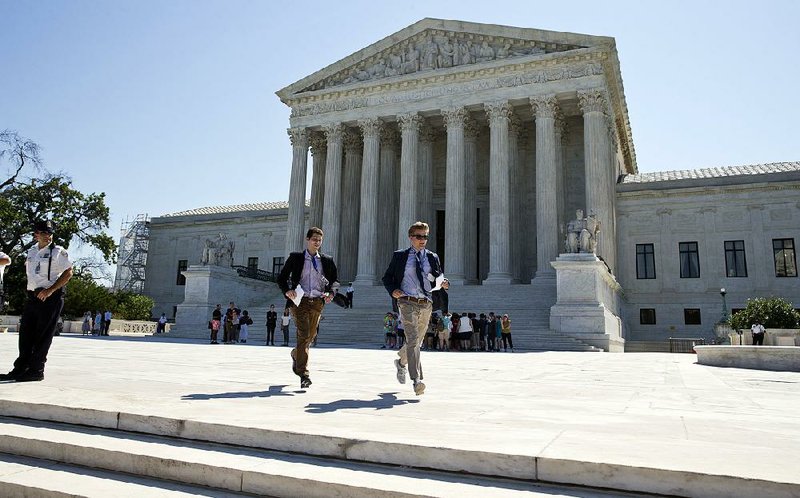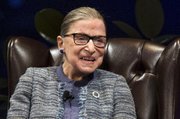WASHINGTON -- The Supreme Court is set to begin its new term as it ended the last one, down one justice and ideologically deadlocked on a range of issues.
The absence of a ninth justice since Antonin Scalia's death in February has hamstrung the court in several cases and forced the justices to look for less contentious cases on which they are less likely to divide by 4-4 votes.
It could be several months, at least, before the nation's highest court is again operating at full strength. President Barack Obama's nomination to the Supreme Court, Judge Merrick Garland, has been blocked by Senate Republicans since March.
"It's a very interesting time at the court. That doesn't necessarily translate into interesting cases. In fact, it may translate into the opposite," said Paul Clement, the George W. Bush administration's top Supreme Court lawyer and a frequent advocate in front of the court.
By law, the court convenes on the first Monday in October. But the key date this year is the second Tuesday in November -- Election Day.
How the presidential election turns out will go a long way toward determining the judicial outlook of the ninth justice, the direction of the court and the outcome of several cases already being heard and others that probably will be at the court soon.
A victory by Republican Donald Trump would mean Scalia's seat almost certainly would be filled with a like-minded conservative. And if any of the three justices in their late 70s or early 80s were to leave the court during a Trump presidency, conservative control could be cemented for a generation.
A win by Democrat Hillary Clinton would be expected to result in the confirmation of Garland, or perhaps a more liberal choice. In either case, Democratic appointees would constitute a majority of the Supreme Court for the first time since the early months of Richard Nixon's administration in 1969.
More significantly, Justice Ruth Bader Ginsburg would lead a liberal majority that no longer would be dependent on the support of a more conservative justice. That fifth vote has typically come from Justice Anthony Kennedy and, less often, Chief Justice John Roberts.
Such a shift could affect the court in profound ways, perhaps causing Roberts to moderate his views on some issues in order to retain the power to shape decisions, said George Terwilliger, a lawyer who has served in Republican administrations and worked with Roberts. The senior justice in the majority assigns the opinion writer in a case.
Roberts "will be seeking, in as many cases as possible, perhaps a middle ground that takes him and perhaps one of his conservative colleagues to a position where they may not want to be," Terwilliger said. "I think that's John's personality."
If the election doesn't yield a clear winner, the court could be asked to get involved, as it did 16 years ago in Bush v. Gore, the case about Florida's disputed voting outcome. The big difference is the court in 2000 was fully staffed and able to deliver a final ruling, even if half the country didn't like it.
The court's term begins with eight justices for the first time in 25 years. Clarence Thomas was confirmed in October 1991, a couple of weeks after that term began.
The other big issue looming over the marble courthouse is when one or more of the older justices might retire. Ginsburg is 83 and has said she will take it a year at a time. She could find herself in a newly powerful role if Clinton is elected, making her less likely to step down, said Thomas Goldstein, who argues regularly at the court.
The two other older justices are Stephen Breyer, 78, and Kennedy, who turned 80 this summer.
few blockbusters
The court's calendar so far is lacking in the kinds of blockbuster cases seen in recent years dealing with health care, gay marriage and abortion rights.
It includes a church's challenge to its exclusion from a state program in Missouri to provide rubberized surfaces in playgrounds, a dispute over whether disparaging names can receive trademark protection from the government, two redistricting cases involving the rights of minority-group voters and two appeals from death-row inmates in Texas.
The Missouri case about the separation of church and state was granted while Scalia was still alive and has yet to be scheduled for argument, and analysts say that might be because the justices think they may divide 4-4. Tie votes leave the lower-court decision in place, but set no national legal rule and essentially waste the justices' time.
"The justices are showing obvious caution. They are not eager to resolve big-ticket questions with eight justices," said Georgetown University law professor Martin Lederman, a former Justice Department official in the Obama administration.
Waiting in the wings are cases involving the rights of transgender people, immigration, climate change, voter identification and religious freedom. These are the sorts of issues that have split the court along ideological lines before.
On Wednesday, the court will hear arguments in Buck v. Davis, No. 15-8049. That case arose from an assertion by an expert witness in the death-penalty trial of Duane Buck, who was convicted of the 1995 slayings of a former girlfriend and one of her friends while her young children watched. The expert, presented by the defense, said black men are more likely to present a risk of future danger.
The justices will decide whether Buck, who is black, may challenge his death sentence based on the ineffectiveness of the trial lawyer who presented that testimony.
"The Buck case raises questions that could not be more relevant to ongoing conversations sparked by police shootings about implicit bias and stereotyping of African-American men as violent and dangerous," Wydra said. "The Roberts court, and particularly the chief justice himself, has often been reluctant to acknowledge the reality of systemic racism in this country, but the egregious facts of the Buck case make it impossible to avoid."
On Oct. 11, the court will consider another biased statement, this one ascribed to a juror during deliberations in a sexual-assault trial.
"I think he did it because he's Mexican, and Mexican men take whatever they want," the juror said of the defendant, according to a sworn statement from a second juror.
The question in the case, Pena Rodriguez v. Colorado, No. 15-606, is how to balance the interest in keeping jury deliberations secret against the importance of ridding the criminal-justice system of racial and ethnic bias.
On Thursday, the court agreed to decide another charged case, Lee v. Tam, No. 15-1293, which asks whether the government may deny federal protection to a trademark said to disparage Asian Americans. Probably, the case essentially will decide a separate one concerning the Washington Redskins football team.
The court also will decide, in Moore v. Texas, No. 15-797, whether Texas may use an idiosyncratic standard in deciding who must be spared execution because of intellectual disability. The state relies in part on what one judge there called the "Lennie standard," which exempts defendants who resemble Lennie Small, the dim, hulking farmhand in John Steinbeck's Of Mice and Men.
Information for this article was contributed by Mark Sherman of The Associated Press and by Adam Liptak of The New York Times.
A Section on 10/02/2016



